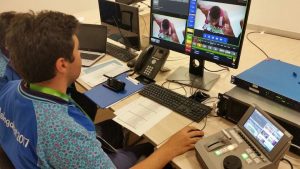SVG Europe Sit-Down: Mo Goyal from Evertz on the IP future and evolving educational requirements

Mo Goyal, Sr. Director, International Business Development – Live Media Solutions, Evertz
With over 1200 employees, including hardware and software engineers, Evertz has a global presence with offices located in Canada, United States, United Kingdom, Germany, United Arab Emirates, India, Hong Kong, China, Singapore and Australia. The company is responsible for delivering complete end-to-end solutions for all aspects of broadcast production such as content creation, content distribution and content delivery. That delivery can be directed at television sets, on-demand services, WebTV, IPTV and mobile devices, such as phones and tablets.
SVG Europe’s latest Sit Down with Senior Director, International Business Development – Live Media Solutions, Mo Goyal, commenced with a look ahead…
What are the challenges facing you in 2018?
For 2018, the biggest challenge we face is our ongoing effort to help the industry with the transition to IP for live production. As we see the number of media companies starting the transition increase next year, we will face the challenge of not only delivering more solutions, but also the support and training of them. Unfortunately, with IP, the industry still faces a knowledge and experience deficit. Thus, we will continue to see closer and more dependencies on the customer/vendor relationship.
We have partnered with several large North American media outlets since 2014 as part of their successful transition to IP. We definitely see IP as Here and Now. With SMPTE ST 2110 well on its way to becoming a standard, we anticipate strong and competitive markets in Europe, Middle East, and Asia. We will need to leverage our experience with the growing number of IP installs using our Software Defined Video Networking (SDVN) to succeed in these markets.
We will also leverage our successes in other venues for Live Production. This year, we saw our SDVN solutions being deployed in a number of stadium and college projects including the Mercedes-Benz Stadium in Atlanta, GA and the University of Notre Dame in South Bend, IN. Our SDVN solutions (including our EXE switch fabric) were used as the core technology of the International Broadcast Centre (IBC) for the 5th Asian Indoor and Martial Arts Games in Ashgabat this past August. The use of IP in Ashgabat is an industry first for this scale of sports competition.
Has the take up on IP technology been as you expected?
In North America, the adaptation of IP using our SDVN solutions by the large media companies has exceeded our initial expectations. We have now started to see a growing demand by other large media companies in other regions.
A number of factors have triggered the increased demand internationally. The work done by organisations – SMPTE, VSF, EBU, IABM, AMWA, and AIMS – on the development of SMPTE ST 2110 addresses the major concern of interoperability by companies. With SMTPE ST 2110 quickly becoming a standard, has removed a major obstacle for IP adaptation – interoperability amongst vendors.

Evertz SDVN solutions were deployed for the 5th Asian Indoor Games in Ashgabat
The other factors are business-related. One, there are increasing demands for UHD productions, thus requiring more bandwidth within the facility. The other factor is the increasing pressure from new competitors for live video such as YouTube, Amazon, and Facebook. Broadcasters need to be more flexible and agile to meet these challenges.
Is more education needed about cloud-based playout technologies?
In short, yes. The speed in which we’ve gone from traditional hardware based master control solutions to channel-in-the-box to now the cloud has been impressive. Our recent deployment of Discovery channels to the Amazon Web Service (AWS) cloud is a perfect of example of the need to understand the challenges of deploying live channels (with live inputs) to the public cloud.
Although other industries have had successes in public cloud deployments, the broadcast industry is still at a nascent stage. During our deployment of Mediator and OvertureRT LIVE integrated playout to AWS, we learned a lot about what is needed – connectivity, tools, and knowledge – to put channels with live inputs into the public cloud.
Instrumental to our success was a strong relationship between Discovery, Evertz, and AWS, that allowed everyone to learn and overcome the challenges we encountered. This was essential to the successful launch of the services. Moving forward, our newly acquired knowledge will enable us to launch more services faster than ever before.
What have been the Evertz solutions that have proven to be most innovative, particularly for sports broadcasters?
For live media production, and specifically sports, the growing suite of DreamCatcher production tools has been a game changer. DreamCatcher, which debuted as an IP-based UHD Replay system, is a platform that leverages IP networking to create efficient live production workflows. Powerful new tools including DC-LIVE-EDIT and DC-MG, enable new and innovative highlight package creations for the live production and multiple distribution platforms.
The DC-LIVE-EDIT is an angle-aware, advanced video/audio editing tool that enables instant craft editing on live inputs with render-free publishing which is critical for quick turnaround packages after events. The DC-MG is our advanced content management system that leverages the DreamCatcher networked architecture for content access, processing, and transcoding for distribution of highlight packages across various distribution platforms.
Both of these DreamCatcher components played a critical role in Perform Group Japan’s streaming platform, DAZN. Earlier this year, DAZN became the host broadcaster – over OTT – for the Japanese domestic football league (J. League). Perform’s production staff utilised DreamCatcher production tools, including DC-LIVE-EDIT and DC-MG, for quick turnaround of highlights for their OTT platform immediately after matches. The user-friendly DreamCatcher interface enabled Perform to quickly train new staff on the platform and grow its OTT offering in Japan.
At NAB NY 2017 you showcased the evREMOTE. Can you tell us more about this solution?
One of the key applications for IP is Remote or At-Home production. Access to higher bandwidth links between venues and broadcast centres is a growing trend. This access has allowed media companies to produce sports events that were previously not economically feasible. This enables the production of more regional content for their platforms.
Both our evREMOTE and 3606 series are essential parts of our Remote/At-Home production solution. Both enable multiple 3G/HD/SD, audio, and data signals to be transported from the venue using compressed (JPEG2000) or uncompressed (SMPTE ST 2110) formats. These platforms allow media companies to reduce the resources required at the venues and efficiently use resources in the broadcast/production facility and thus reduce their overall production costs.
Finally, can you provide a few hints concerning upcoming Evertz developments with implications for sports broadcast.
The biggest development will be pulling all these technologies together and to change and modernise the production workflow to allow media companies to create more content for more platforms.
This transition to IP is not about replacing an SDI connector between devices with Ethernet. It’s about rethinking the rigid and linear workflows that is based on SDI. With IP, we have access to sources everywhere thus creating flexible and scalable workflows that meet the requirements of the job. Resources can be allocated from small to large productions based on a schedule. Media companies can also be more agile to address consumer preferences and deliver content that appeals to them faster than ever before.

